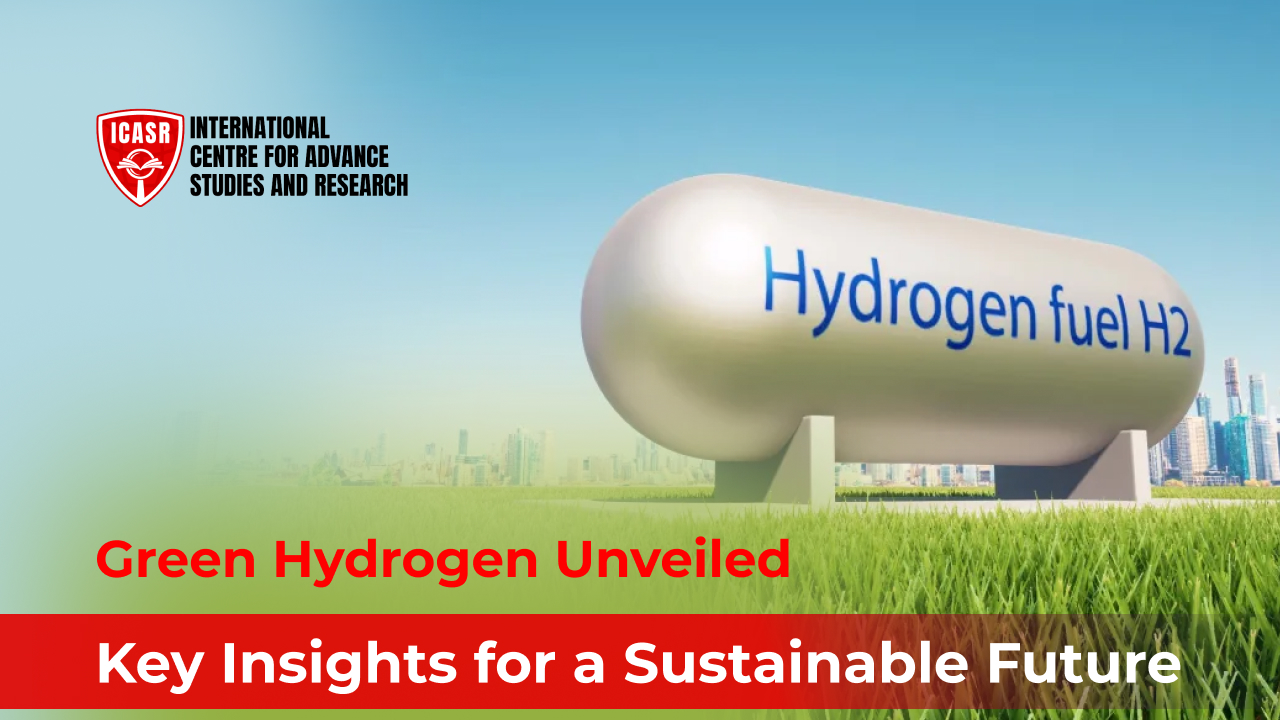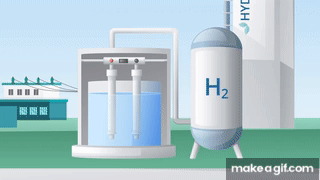Green Hydrogen Unveiled: Key Insights for a Sustainable Future

In the journey toward a cleaner and more sustainable world, green hydrogen has appeared as an encouraging energy carrier. It is a carbon-free alternative to ordinary fossil fuels which are derived from renewables. This detailed study looks into the important elements of green hydrogen, its production methods, uses, and possible influence in creating a sustainable tomorrow.
Understanding Green Hydrogen
Green hydrogen is created through electrolysis, a process that employs renewable energy to split water into hydrogen and oxygen. Unlike conventional hydrogen generation strategies that depend on fossil fuels, green hydrogen offers a carbon-free elective. The renewable energy utilized to power the electrolysis prepare can come from sources like solar, wind, or hydropower, guaranteeing a sustainable and environmentally friendly production cycle.
Key Benefits of Green Hydrogen:
- Decarbonization: This essential tool to counter global warming is very much required because green hydrogen is a fuel without greenhouse gases when burnt therefore whilst fossil fuels can be substituted with it they will greatly reduce our externalities and global temperatures.
- Energy storage: Green hydrogen is the answer for intermittent renewable sources of energy such as solar and wind which can be stored easily. Hence, in these periods when generation from renewable sources is low, it is possible to store excess renewable energy as hydrogen for use later during times when the power supply is stable and reliable.
- Multifunctionality: This means that green hydrogen may be used for different areas including transportation, generation of electricity as well as industrial process. It therefore serves as an integral resource in facilitating an economical transition from conventional forms of energy.
The Role Of Green Hydrogen in a Sustainable Future:
Green hydrogen has various essential roles in achieving and maintaining a sustainable future:
- Carbon Neutrality: Production of green hydrogen does not emit any form of greenhouse gases thus enabling it to become part of efforts aimed at mitigating climate change.
- Innumerability: Green hydrogen can work effectively in different sectors such as transport, production and even generation of power which makes it flexible hence reducing dependency on fossil fuels.
- Power Souring: It can hold extra renewable energy, thus stabilizing grids and ensuring a constant power supply.
- Job Opportunities: Establishing industries that use green hydrogen will generate new employment opportunities and economic expansion.
Production Methods of Green Hydrogen:
Green hydrogen can primarily be produced through the electrolysis process which involves the splitting of water using current to yield hydrogen and oxygen gases. For this purpose, different types of electrolyzers are used each having its unique advantages and disadvantages:
- Alkaline Electrolysis: A mature technology that employments a potassium hydroxide or sodium hydroxide electrolyte.
- Proton Exchange Membrane (PEM) Electrolysis: A high-efficiency innovation that employments a polymer membrane to partitioned hydrogen and oxygen.
- Solid Oxide Electrolysis (SOE): A promising innovation that works at high temperatures, offering improved proficiency.
The choice of electrolyzer innovation depends on variables such as productivity, taking a toll, and the particular application prerequisites.
Application of Green Hydrogen:
Several industries could benefit from using green hydrogen:
- Transport: Using hydrogen-powered vehicles could revolutionise the way we transport goods, making them friendly to the environment and more energy efficient compared to petrol/diesel automobiles. Trains like these have been set to operate in some parts of Europe while hydrogen aircraft are being conceived worldwide.
- Industry: Using green hydrogen as a feedstock for industrial procedures like steel production, ammonia creation and refining among others, will minimize dependence on fossil fuels and their corresponding emissions.
- Electricity Generation: In fuel cells, green hydrogen can be converted into electricity thereby providing a reliable source of power to the grid. Hydrogen fuel cells also work great in off-grid situations like disaster relief done in remote areas and rural settlements.
- Residential and Commercial Heating: Hydrogen that is green in colour can be utilized for heating as well as the production of hot water thus aiding in the decreased dependence on oil products and enhancement of indoor air quality.
Case Studies:
Several nations and territories are actively working on green hydrogen projects. Germany, for instance, has set daring goals for producing and using green hydrogen to become a global leader in this area. Similarly, Australia, which possesses an abundance of sources of renewable energy, is investing significantly in green hydrogen endeavours. The examples given in this regard illustrate that there is an increasing interest in as well as enthusiasm for the development of green hydrogen.
Challenges and Opportunities:
Green hydrogen is faced with numerous obstacles even though it has great potential:
- Cost: At the moment, generating green hydrogen is too expensive when placed alongside fossil fuels which makes it unmarketable. Nevertheless, advancements in technology and economies of scale are poised to reduce prices.
- Infrastructure: Great investment is needed to make the desired infrastructure including hydrogen-producing facilities, storage, and distribution networks.
- Policy Support: To drive green hydrogen adoption and create a favourable market environment, government policies and incentives are critical.
But, at the same time, great possibilities exist for both improvement processes along creative thinking:
- Technological Advancement: Continuous exploration plus invention is resulting in better electrochemical device conductance, lesser expenditure requirements as well as long-lasting properties.
- International Cooperation: Accelerating the growth and use of green hydrogen technologies is possible through joint efforts among nations.
- Market Expansion: The rising need for clean energy is likely to increase the market for green hydrogen, thereby urging investments and innovations.
Additional Considerations:
- Hydrogen Storage and Transportation: Essential for mass adoption are effective and secure strategies to store and transport hydrogen since its storage and transportation are crucial issues.
- Safety and Regulations: Appropriate regulations and standards are necessary for ensuring that hydrogen is handled and used safely.
- Union of People: Public enlightenment and safety questions regarding hydrogen are very vital in its successful incorporation into society.
The Role of Policy and Investment:
In facilitating the adoption of green hydrogen, government policies and investments are paramount. The government can provide incentives, subsidies and also regulatory support making it easy for green hydrogen technologies to develop and be used. In addition, global cooperation is key in tackling the universal challenges that come with climate change and moving toward a sustainable energy future.
The Future of Greenhouse Hydrogen:
With the ability to have an important role in meeting the requirements of an energy future that is sustainable and decarbonized, there remains a high level of hope for green hydrogen. Since green hydrogen has been able to tap into various potentials while tackling existing challenges, it may become one of the foundations of a clean energy economy that will ensure a safer planet and richer society.
Green Hydrogen Market Size: A Growing Industry:
The fast-expanding market for green hydrogen is being powered by rising global attempts to lower carbon output and switch to renewable draft sources. Although it is modest now in 2024, the industry anticipates that demand will grow considerably shortly.
Recent Market Estimates:
Different market research firms have given figures for the global green hydrogen market size:
- MarketsandMarkets: the global green hydrogen market was worth $1.1 billion in the year 2023 and is predicted to be valued at $30.6 billion in 2030, with a tremendous growth rate of 61.1% per annum on average from this period onwards.
- Precedence Research: The size of the global green hydrogen market was estimated to be USD 6.26 billion in 2023 and it is likely to reach over USD 165.84 billion by 2033 growing at a CAGR of 38.77% from 2024 to 2033.
- Plug Power: As of 2024, the market reached a size of more than USD 649 million, with an expected compound annual growth rate (CAGR) of upwards of 31% from 2023 through 2031.
Factors Driving Market Growth:
The expansion of the green hydrogen market is due to many different factors:
- Growing need for clean energy: The use of solar power, wind power and other types of renewable energies is becoming important in our countries and continents. So, there’s no doubt that green hydrogen want will become more prominent in future.
- Improvements in electrolysis technology: Technological advances have led to more efficient and cheaper ways of producing green hydrogen through numerous developments in electrolysis methods.
- Government Assistance: All over the world, governments are taking steps by way of incentives and investments to promote growth in the green hydrogen sector.
Key Takeaways:
- There is an eco-friendly, eco-conscious substitution for crude oils called green hydrogen.
- It is important for the production of green hydrogen by renewable energy sources through electrolysis to have its environmental advantages.
- In diverse use cases, green hydrogen finds its utility in modes of transport, industries and the generation of electricity.
- This means going over all the hurdles including high prices and poor infrastructure for it to be adopted widely in the world.
- The expansion of the green hydrogen industry is propelled by technological advancements, international cooperation, and market expansion.
In our quest for a clean energy-driven future, we must acknowledge the possibilities of using green hydrogen while addressing its drawbacks. The most important advantage of utilizing green hydrogen is that it serves as a sustainable source of energy free from carbon emissions. Additionally, it has versatile features including energy storage potential – which makes it a huge tool in terms of dealing with climate change. We need to overcome the obstacles presented by green dictation on one hand and take advantage of its potential at the same time if we want to achieve a more progressive and sustainable tomorrow.

